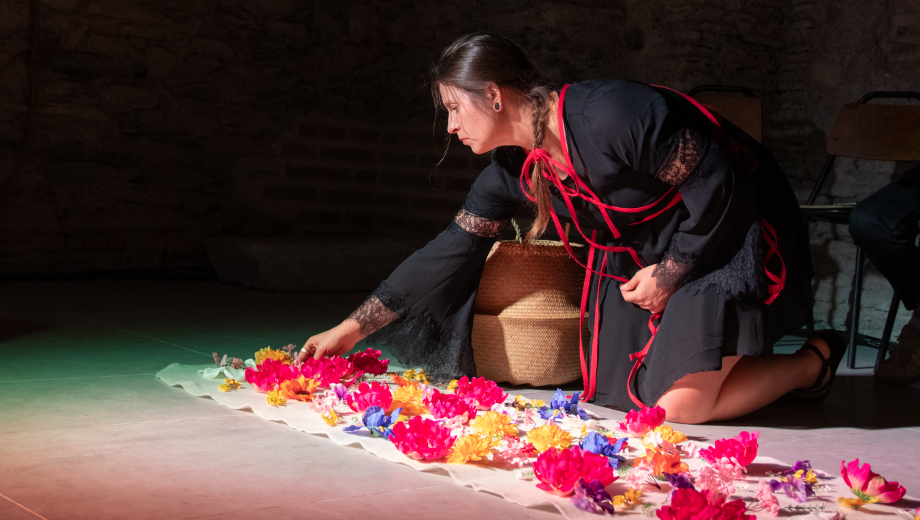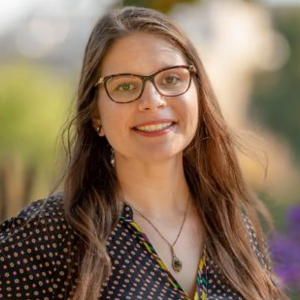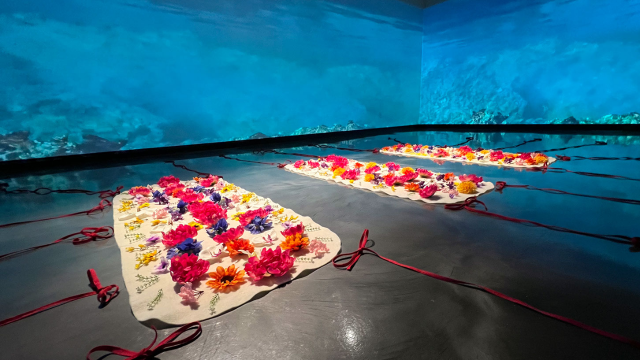
The artist performance “In Memoriam” by Katina Bitsicas uses silk flowers to adorn wool shrouds with a skeletal-like floral pattern and ties red jute ribbons around the pillars of a 12th century Byzantine bath house to serve as a remembrance for a lost loved one. This multimedia performance honors the artist’s Greek heritage and the resting place of her father, the Aegean Sea. This performance was presented in Thessaloniki, Greece for the 57th Dimitria Festival, sponsored by Eye’s Walk Festival and curated by Filia Milidaki.
Most people understand the role art plays in our lives. We might love the way a song makes us feel or note how a painting captures our eye. But most of us don’t consider studying the benefits of consuming or creating art.
Katina Bitsicas, assistant professor in the School of Visual Studies and an accomplished artist, researches how art can be used to explore grief, loss, trauma and memory. Her latest research explores how digital storytelling can help people better cope with their grief after losing a loved one.
Bitsicas also is exploring new technologies, such as using artificial intelligence (AI) in her research, which she has been given the time and space to do through the Arts & Humanities Research and Creative Works Fellows Program. A partnership between the Office of the Provost and the Division of Research, Innovation & Impact, the program aims to create structures, supports and mentoring for early and mid-career faculty who engage in the arts and humanities. The program provides a mentor, grant-writing support and more.
We talked with Bitsicas about her art and research and how the fellows program is supporting and helping shape her next steps.
Tell us a little bit more about your research. What does the data say about how digital storytelling can help participants deal with the loss of a loved one?

Through my collaborative research with faculty from the MU School of Medicine, we have developed an intervention where participants who are recently bereaved create their own digital stories using images, videos and their recorded narrations to tell an aspect of the story of their loss and the caregiving and/or grieving process. The participants are encouraged to express the way the loss made them feel and how it affected them. Through the process of creating and then sharing their stories in a group setting, they can make meaning of the loss they endured and recognize how the loss shaped them into who they are today.
Qualitative data reveals that for some, participation in digital storytelling facilitates growth and meaning making, suggesting the clinical applicability of digital storytelling. Themes from the data also reveal that participation helps the organization of thoughts and emotions about the loss, encourages confidence in the ability to discuss feelings with others and serves as a source of closure. Data also reveals that participation in digital storytelling contributes to personal growth. Specifically, participants cite they felt a sense of pride in their newly acquired digital skills as well as a sense of mastery over their own self-narrative.

"In Memoriam" includes a projection mapping of the Aegean Sea.
How have you used art to make meaning in your own life?
I use art to both memorialize and make meaning of the loss of my father. My most recent solo exhibition, “In Memoriam,” which is on display through March 10 at Elon University, celebrates the life of my father by creating the funeral he couldn't have due to COVID-19. This work is a nod to my familial history and the memory of my father but is also symbolic of the collective grief and trauma our world is going through that motivates an emotive and healing response.
“In Memoriam” consists of an immersive projection-mapped video installation of the Aegean Sea, a documentation of an
artist performance, sculptural artifacts from this performance,
an artist book and an augmented reality work. The 2 ½-hour-long performance was realized in a late 12th-century Byzantine bathhouse, a UNESCO world heritage site, in Thessaloniki, Greece. Included in this performance is the tying of red jute ribbon around the pillars of the bath house, which is inspired by the painted ribbons on the stelai of the historical Greek burial sites. The red threads signify a connection to the dead, and back to the Earth, and a link to my Greek heritage.
The artist book, titled “farewell_father,” documents my caregiving journey and an augmented reality work, “How long after this before I’m gone?” emphasizes the reality of what our bodies can do to us and how we process and make sense of these life events.
How did you land on this area of study?
I’ve always been interested in normalizing conversations about death and dying, something that isn’t as common in Western culture.
Since graduate school, my work has used art to cope with trauma and to connect with other individuals with similar experiences. In 2015, my first year at MU, I facilitated a workshop on using digital storytelling to tell health stories and met my collaborator, Abigail Rolbiecki, assistant professor in the School of Medicine. Soon after we began developing these bereavement interventions and delivering them to a variety of populations.
These themes are also the focus of my undergraduate Arts, Social Sciences and Humanities Scholars research group, the Art of Death.
What prompted you to apply for the Arts and Humanities fellows program?
I was excited to see Mizzou investing in the arts and humanities to support faculty research. When I applied, I was at a point in my career where I was just wrapping up one body of artwork and ready to start a new one. I loved how the program was project-based and allowed me the time and space to think in an open-ended way about my artistic practice. I am also going up for tenure this year, so I thought it was a good opportunity to have one final push research-wise before submitting my packet.
How has the program been so far? What are some of the main things the program has helped you with?
The program has been great! I’m really enjoying working with my external mentor, and I am learning so much from her as a full professor who also combines new media with health-related research.
The fellows program has also helped foster applications to other programs and opportunities, such as the Fulbright Scholars Program and the Rome Prize. I was able to really hone in on the important elements of my project proposal for applications to these other opportunities. It’s also given me the time to explore new technologies to incorporate into my artistic practice, such as AI and interactive projection mapping.
What are you hoping to accomplish next through the help and the resources of the fellows program?
I am hoping to finish the first phase of my project which uses an AI chatbot to translate grief and loss. Currently, I am creating a dataset for an AI “advice bot” that generates phrases of advice when asked a question and is created from text messages, videos and audio recordings of my father giving me advice while he was alive. The bot delivers intelligent responses based on what my father would say were he alive.
The program has given me time to work on applications for funding and residencies to support the second phase of the project, which uses this bot for a live, interactive digital performance. I am interested in the social and ethical implication of what it means to literally bring a portion of someone’s being back to life to be translated through digital processing.
What would you say to other faculty members who are considering applying for the fellows program?
I would say, “Apply!” Not only does this program give you the opportunity to meet other scholars outside of your department, but it also enables you to make professional connections outside of the institution because of the external mentor portion. This part has been invaluable to my development as a researcher and an artist and has helped me craft language to describe my interdisciplinary practice.